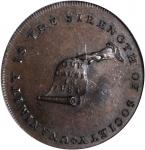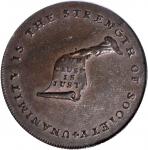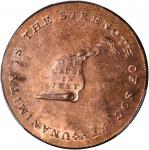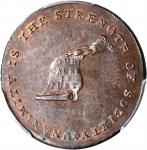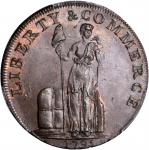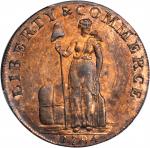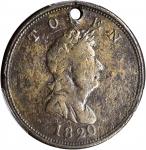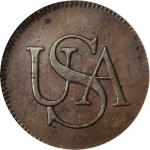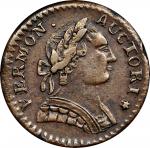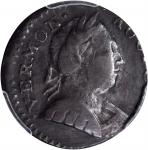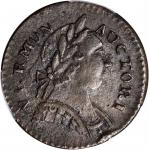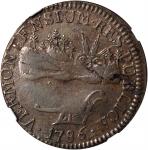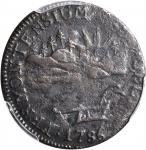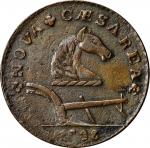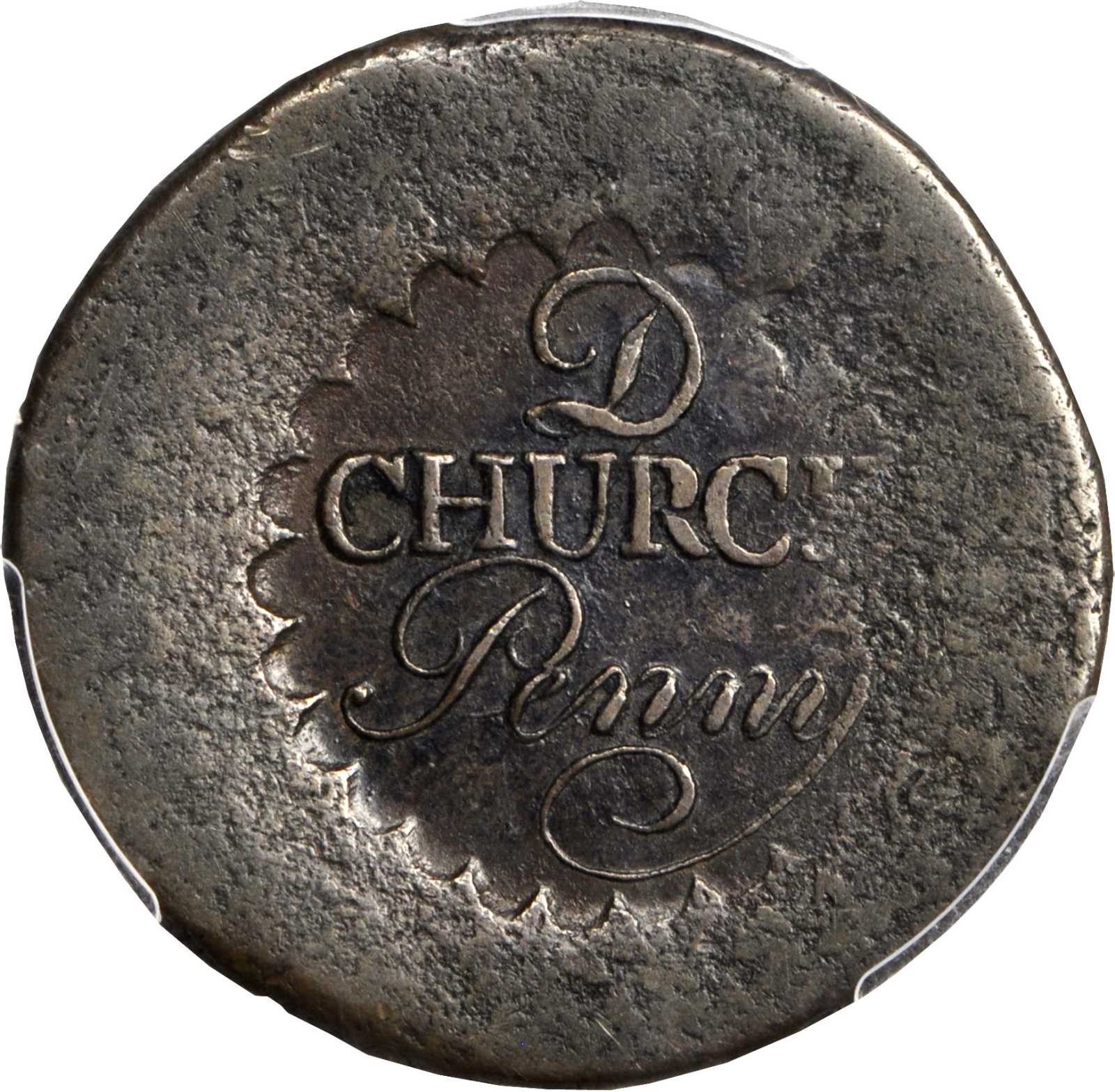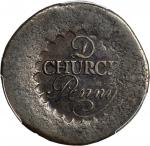Undated (1790) Albany Church Penny. W-8500. With D Added. EF-40 (PCGS). CAC.;121.3 grains. A beautiful example of the most popular American communion token, struck over a very well worn English halfpenny that was still circulating in the Hudson Valley a century after it was made. The struck portion is glossy dark chocolate brown, with some ancient and harmless buildup around the lettering. Only the final H of CHURCH is softly struck, and most of the decorative cartouche is well rendered as well, missing only between 2 oclock and 4 oclock. The undercoin is more granular and shows its century-worth of small marks, including two small nicks on the rim visible from the reverse. The smooth reverse area opposite the struck portion shows some gentle hairlines, but to no great effect. When the struck area is positioned upside down, the bow in Williams hair is seen below the top of the final H of CHURCH, and the truncation of his bust is at 6 oclock, below the top of D. A particularly fine example.
In our (Stacks) Ford II sale of 2004, we offered specimens of both with D and No D varieties. The With D brought more than the No D, but perhaps not enough more to give this variety its proper premium for rarity. Long assumed to be of about the same rarity, it actually looks like this variety is the rarer of the two by a significant margin. Michael Hodder recorded just five specimens known to him: the Ford coin, boldly overstruck on a George III counterfeit halfpenny; a specimen in the Partrick collection; one in a well known Rhode Island collection, also overstruck on a George III counterfeit halfpenny; the Robison-Roper coin; and the Picker coin. We can add two to the list, aside from this one. The Breen plate coin for this variety is pedigreed by Breen to a "Pvt. Coll.," but its actually the ANS coin, ex Howland Wood, and has been there since 1911; it is the only Albany Church penny in the ANS holdings. There was also a newly discovered specimen, a very nice one, sold in Heritages January 2012 sale for $115,000. That one, like this coin, was struck over an extremely worn William III halfpenny; it was graded PCGS EF-45+. Since Ford, the Ford specimen has resold in the Heritage January 2007 sale, now graded PCGS VF-35, at $74,750. Other than the present example, we have sold two Albany Church pennies since Ford, though both were the No D variety: one in our (Stacks) 2009 ANA sale graded VG-10 (NGC) and another in our November 2011 sale graded Fine-15 (PCGS) that was boldly overstruck on a (likely counterfeit) 1771 English halfpenny. PCGS has graded an example of this variety on five occasions, though we believe this total to represent at most four specimens, and more likely three. Only this example and the Heritage January 2012 coin are imaged at <em>PCGS CoinFacts</em>.
Garrett had just one Albany Church penny, a holed example of the No D variety, earlier from the John Story Jenks sale, where it was the only specimen (the Jenks sale said it came from Mills, but none appears in the 1904 Mills sale, so it must have been a private sale). Mickley also had but one, though the catalog didnt say which variety. Several major collections had specimens of the No D but not the With D: Edward Maris (1886); Matthew A. Stickney (1907); Herbert Oechsner (1988). Roper owned specimens of both varieties, neither as high grade or complete at this one. His With D was earlier sold in our (Stacks) 1982 Robison sale, where it was the only example offered. Parmelee also owned both varieties, of course, as Parmelee had everything, and Picker owned specimens of both varieties also. There were two specimens in Woodwards April 1863 Brooks and Finotti sale; interestingly, the specimen with the D (i.e., this coin) brought $25, against $18 for the variety without it, though Woodward said they were in the same condition. Bushnell bought both, and both reappeared in the 1882 Bushnell sale. In a later public auction appearance of this coin, in our (Stacks) 1976 ANA sale, we noted that "we can find records of three other specimens being sold at Public Auction, all without the D above CHURCH," naming our (Stacks) sale of property from the Massachusetts Historical Society in October 1970, the Jenks sale of 1921, and the George Clapp coin in Schulmans sale of April 1959. As of 1976, it looks like it had been almost a century since an example of the With D variety had sold publicly, and Bushnell may have been the last offering. The First Presbyterian Church of Albany retains one specimen, the No D variety.
The Lasser Collection at Colonial Williamsburg also includes a specimen of the No D variety, but not the With D. Crosby did not own an Albany Church penny of either variety, nor did Earle, Zabriskie, Jackman, Laird Park, Eliasberg, or Steinberg. Shockingly, James Ten Eyck didnt own one either, despite having a magnificent cabinet of colonials and despite being from Albany. None appeared in the Newman sales, but given Eric Newmans abiding interest in this issue, he may have one that the EPNNES has decided to retain. Likewise, none appeared in the Norweb sales, and as the Smithsonian does not hold a specimen from Mrs. Norwebs donation or any other source, it appears she never obtained one.<p>While MHS was a known consignor to the 1976 Stacks ANA sale, and W.S. Appleton built most of their numismatic collection in the last quarter of the 19th century, how Breen determined this was the specimen in Woodwards April 1863 sale is not known. Bushnell bought both examples out of the sale (mentioned in the 1882 Bushnell sale, lots 897 and 898, but Breen does not mention the Bushnell sale in his <em>Encyclopedia</em> pedigree of this coin). Unfortunately, the Bushnell sale plates illustrate neither Albany Church penny. Either Breen accidentally omitted the Bushnell provenance, or he was guessing when he said this was from the April 1863 Woodward sale. Unfortunately, either mistake is equally possible. This piece was published and illustrated in <em>The Colonial Newsletter</em>, Volume 1, Number 1, page 4, where Phillip Greco reported it as a previously unknown die variety (which suggests how long it had been since one was on the market prior to 1960).
At the time, it was in the collection of the Massachusetts Historical Society.;From the Antony Bettencourt Collection. Earlier ex Massachusetts Historical Society; our (Stacks) 1976 ANA sale, August 1976, lot 78; our sale of the Henry P. Kendall Foundation Collection, March 2015, lot 2530. According to Breens Encyclopedia, also from W. Elliot Woodwards sale of April 1863, lot 2080; William Sumner Appleton. Paper envelope with collector notes included.

